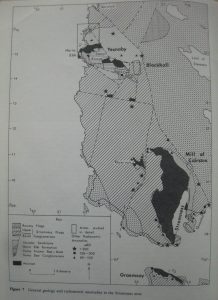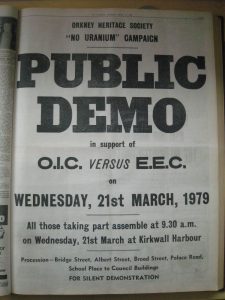Deep Time Materials: Uranium
The first time we walked together along Stromness’ West Shore, our artist-in-residence Anne Bevan told us a story. She remembered coming down to the beach with her dad to collect the seaweed that washed up on the shoreline. The seaweed was destined for the garden, to be used as fertiliser.
Then, listening to the news that night, they heard that there had been a leak of waste material from the Dounreay nuclear power station across the Pentland Firth. Radioactive particles were being washed up along the shore. Seaweed is a known accumulator of radionuclides; so any found along the coast had a high probability of contamination. If it was used as fertiliser, the nuclear waste would find its way into the food chain. And so the seaweed they had collected never made its way onto the vegetable patch.
This story of a radioactive arrival on the shore echoes that of a much earlier arrival, when the ground under what is now Stromness was forming at the margin of the massive freshwater Lake Orcadie. Devonian sediments shed (between 420 and 360 million years ago) from metamorphic rocks containing a number of heavy minerals, which were then sorted by the action of the sea, creating a concentrated ‘placer deposit’ of Uranium within Orkney’s Old Red Sandstone. There it rested for hundreds of millions of years. Until another arrival: in 1973, when UK Atomic Energy Authority geologists published the results of a reconnaissance for uranium. The prospect that uranium mining in Orkney might prove economically viable led to South of Scotland Electricity Board carrying out exploratory drilling in 1976 to establish the extent of the deposits. It is here that the story of Orkney’s geological history intersects with Orkney’s political history. Uranium, whose presence reveals a story millions of years in the telling, had now arrived on Orkney’s shores as a political issue.

Map of radiometric anomales identified by borehole drilling, from Michie and Cooper 1979.
The threat of mining – and the extent to which Orcadians could exercise self-determination in order to resist it – came to dominate campaigning in Orkney both for the 1979 Scottish Devolution referendum and the 1979 General Election. On 21 March 1979, over a thousand turned out for a silent demonstration in Kirkwall, expressing the determination that the Uranium should be left in the ground. The following week, Orkney residents debated with representatives of the electricity board in a five day public enquiry, at which the Orkney Islands Council declared that Uranium would mean the economic ruin of Orkney, destroying the islands’ four main industries of fishing, farming, tourism, and whisky distilling.

Full page advert in The Orcadian, 15 March 1979
So many of the people we spoke to during our fieldwork in Orkney emphasised the way in which the Uranium controversy transformed the political landscape. It generated an urgent sense of Orkney’s need to look out for its own interests, as distinct from those of London or Edinburgh, and brought people together in a common cause who had previously been at one another’s throats. As was written in an editorial in The Orcadian 29 March 1979: “what however was most significant was the utter dedication of a few Orcadians and ‘naturalised’ Orcadians to fight the good cause, among them people who have often been on opposite side in previous local issues”. Indeed, Uranium changed the course of people’s individual political biographies. Some who had previously had no interest in politics at all found themselves ‘awakened’ by the Uranium issue. Many who were schoolchildren at the time describe the events as formative, recalling the almost carnivalesque atmosphere of the protests against further exploration that would lead towards the mining of Uranium: the joy of ditching school, the spectacle of people lying in the road to prevent vehicles and equipment involved in the prospecting being unloaded from the ships, the determination that the land would not be despoiled by a ‘poison mine’.
The apparent mismatch between biographical time and deep time presents itself as a problem of scale: our life stories seem be hopelessly, impossibly out of step with the stories of the landforms under our feet. But here deep time protrudes into the particular present of our human lives.
Different temporalities intersect: human life history; geological formation; the half-life of radioactive material. To grasp what is happening in the present requires thinking about times that reach into the past, and fan out well into the future. As was explained in a feature in The Orcadian of 29 March 1979, tailings from mining would remain radioactive for 80,000 years: “We would bequeath covered piles of them to future Orcadian with instructions how to avoid them and how to keep the fences repaired. I must say the thought of communicating warnings to Orcadians living in the year 5000 daunts me, but 80,000 years hence!”

Panoramic view of Stromness’ West Shore, photo by Carina Fearnley
To go back to our walk with Anne Bevan among the seaweed: I find myself reminded of previous work Anne has done in collaboration with the archaeologist Jane Downes, exploring the folklore of the Nuckelavee, the dreadful devil of the sea: skinless, fleshy innards of human fused to the fleshy innards of a horse; slimy, oozing, bringing a plague upon the islanders. According to the farmer and folklorist Walter Traill Dennison it was the burning of seaweed tangles that threw Nuckelavee into a rage. The potash-rich product of this kelp burning (a major Orkney industry from 1722 onward) had lucrative uses in the glass and soap industries; but the choking flames from the burning enraged the Nuckelavee and threw him into a fury which he took out on the islanders in the form of plague. Thinking about the radioactive seaweed, I’m reminded of the story and its horror as it resonates with more recent nuclear anxieties: what washes up on the shore as economic potential and choking poison, opportunity and destruction.
In 1980, shortly after becoming Prime Minister Margaret Thatcher visited Orkney, to reassure islanders that the idea of mining Uranium had been put in “cold storage”; “For the moment, we have enough to meet our needs.” Yet ‘for the moment’ still carried with it a sense of threat. As George Mackay Brown wrote in a letter in the wake of Thatcher’s visit: “The Uranium is slumbering among its rocks… What will Stromness be in fifty years time?” The potential of the Uranium’s deep time emerges into the present, and does not go away.
